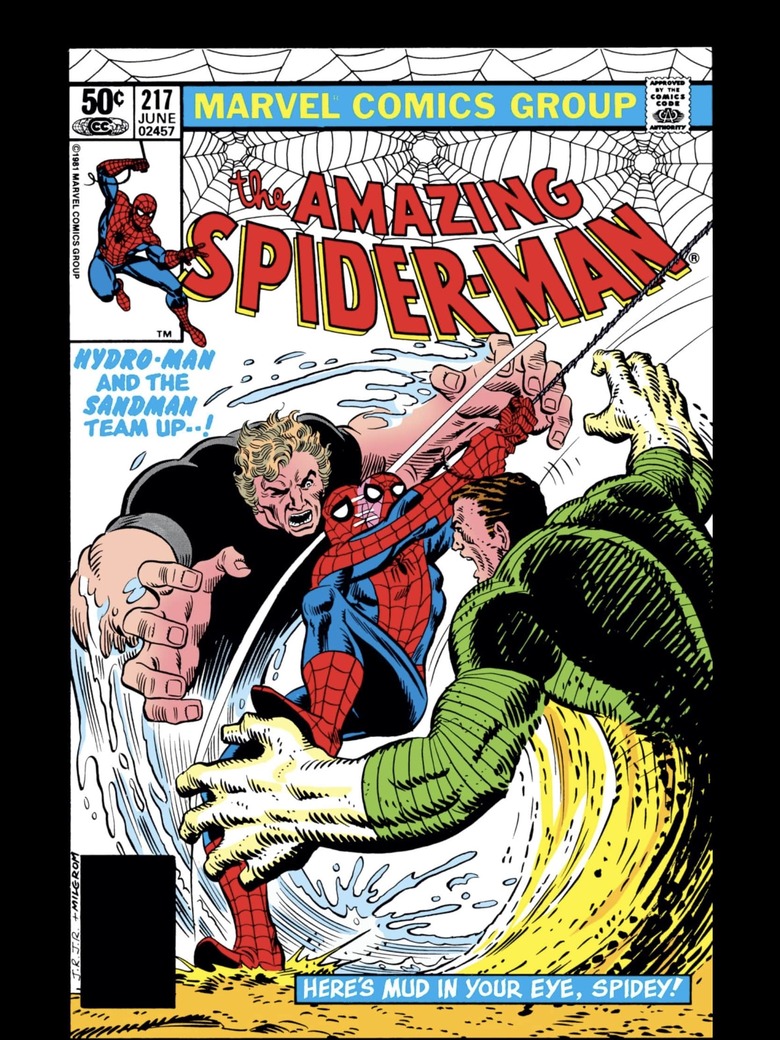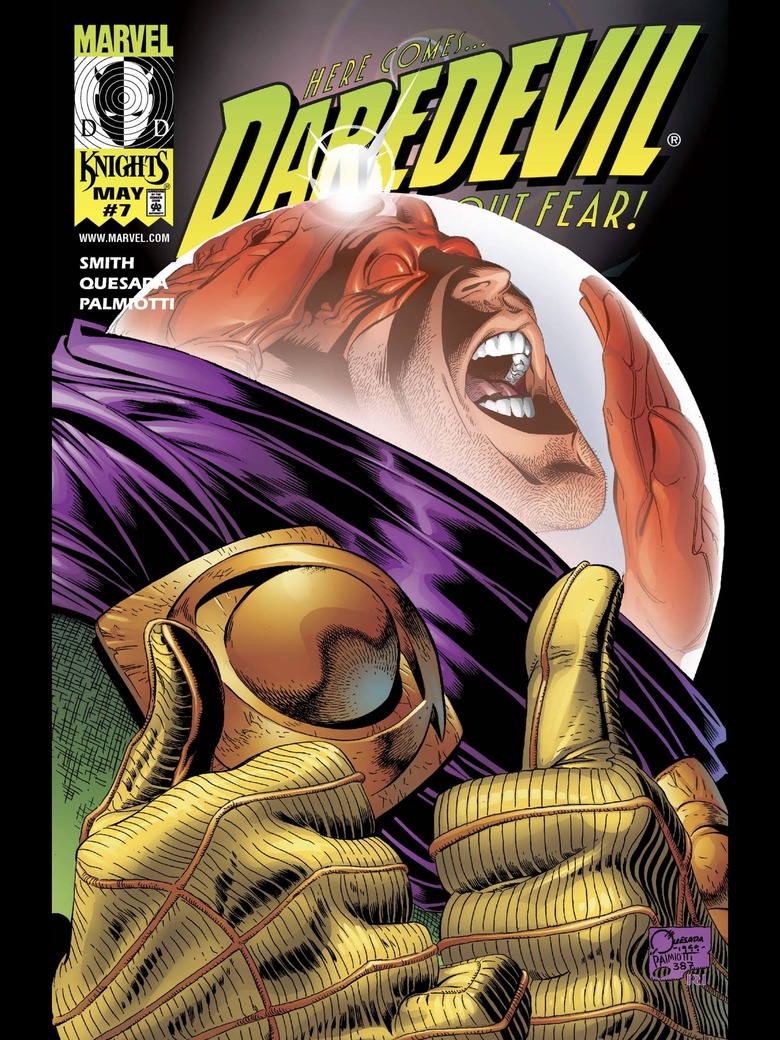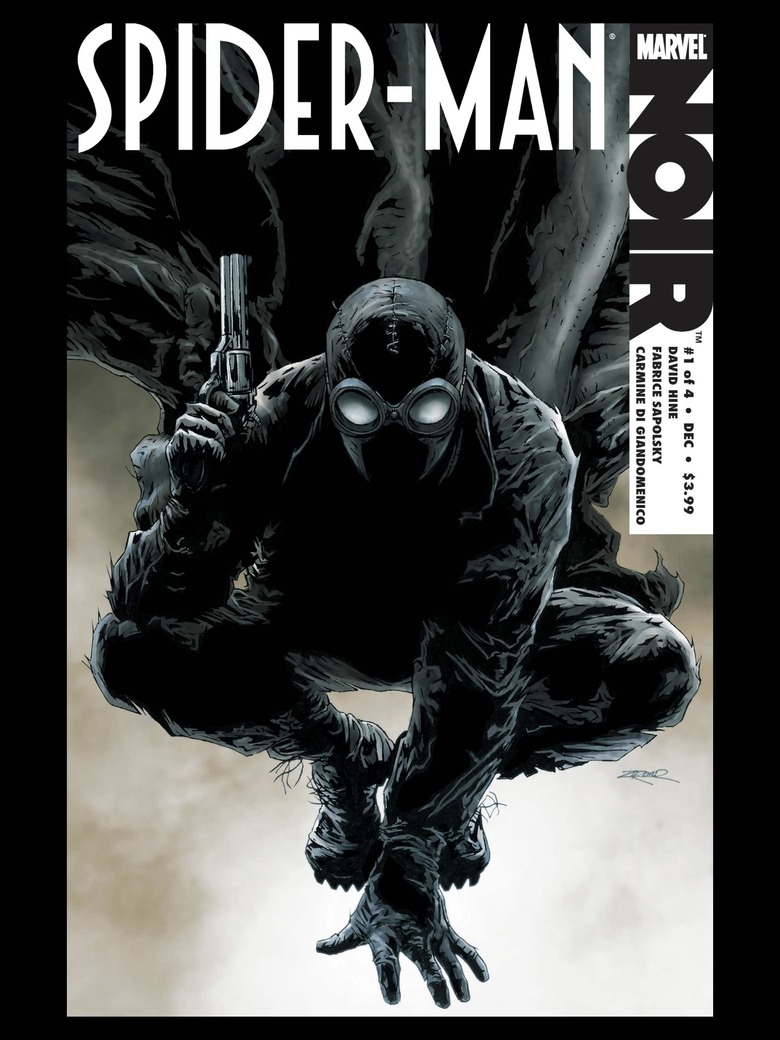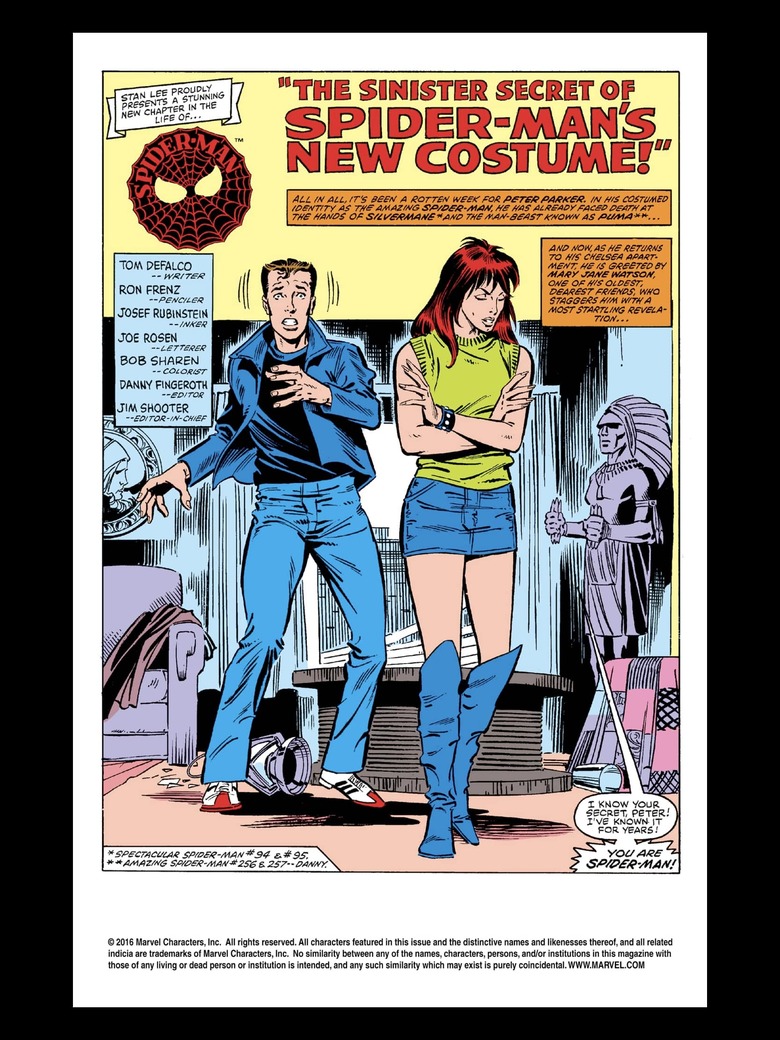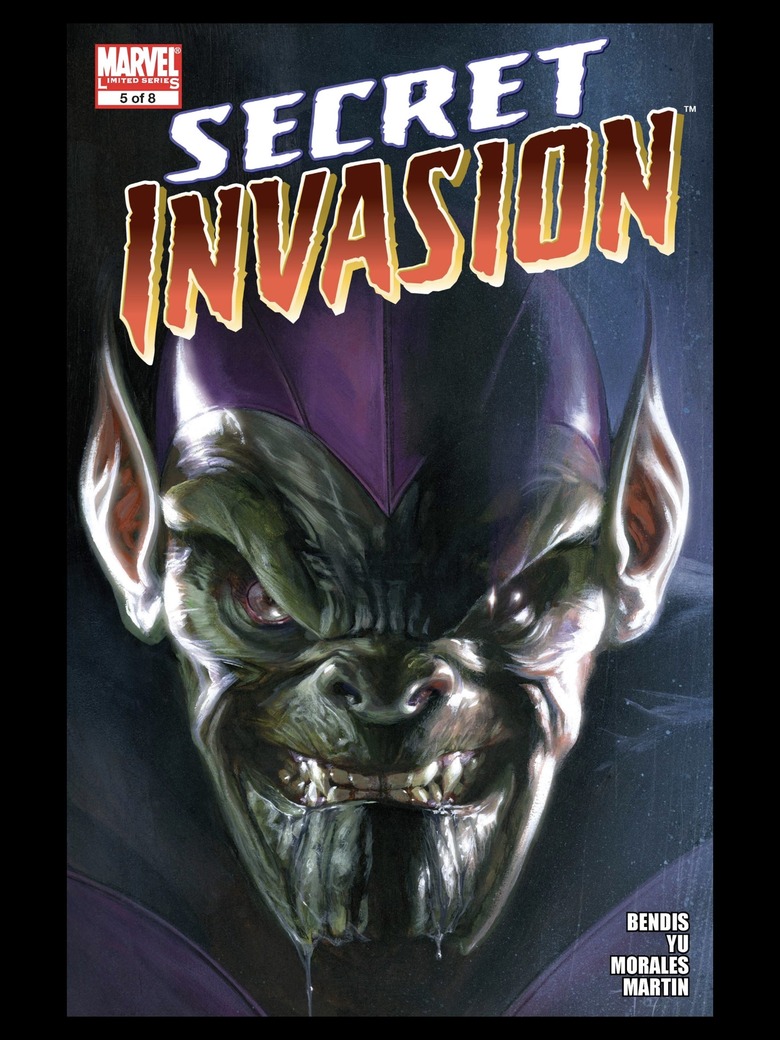How 'Spider-Man: Far From Home' Draws From Comics History And What Its Ending Teases Mean For The MCU
Face front, true believers: there's a new Spider-Man movie in theaters. At twenty-three films and counting, the Marvel Cinematic Universe has been going on long enough now that it has its own history and needn't be a slave to comics history (not that it ever was). Reviews have nonetheless pegged Spider-Man: Far from Home as one of the more comic book-y entries in the MCU.
While it strays from its source material in some notable ways, leaning into a more tech-friendly interpretation of the Spider-Man mythos, there are a number of plot points in the film that do draw from Marvel Comics tradition. Sometimes they're just subtle nods, Easter eggs for eagle-eyed comic readers to spot. Other times, having knowledge of movie and comics history may be essential for understanding the significance of certain moments, including those that we see play out in the requisite mid-credits scene and post-credits scene.
If anything left you scratching your head in Spider-Man: Far from Home, or you just want to have a deeper appreciation for the layers of history behind the web-slinger's Old-World summer adventure in Europe, then don your best fishbowl helmet and let's take a spoiler-filled dive into those right now.
Sandman, Hydro-Man, and the Elementals
Beginning with its opening scene, Far from Home introduces us to a series of CG monsters with elemental powers. Quentin Beck, AKA Mysterio (Jake Gyllenhaal) eventually explains that they are "creatures formed from the primary elements: Air, Fire, Water, Earth."
Creatively dubbed the Elementals (because what else are you going to call them? Planeteers?) these beings are an extremely loose adaptation of four Marvel Comics villains. They take their name from a lesser-known team in the comics but the members are switched out here for villains with corresponding powers who have more of a history with Spider-Man.
Sandman is relegated to a cameo in the desert at the beginning of the movie. Nick Fury and Maria Hill are in Mexico when they encounter the first of the Elementals. At this point, we've seen the Sony logo onscreen but the Marvel Studios logo hasn't even popped up yet. It's just a short prologue sequence that introduces Beck as he fights back the living sandstorm of the Earth Elemental and seemingly saves the day.
In the comics, Sandman was a member of the Sinister Six who tried to leave the criminal fraternity and go straight. He straddled the line between hero and villain and was enough of an A-lister among Spidey's rogues that Sam Raimi wanted to use the character as the main villain for Spider-Man 3 (until the studio began pushing for fan-favorite baddie Venom to be included). Raimi requisitioned actor Thomas Haden Church, who was not far removed from his Sideways Oscar nomination at the time, to play the character opposite Tobey Maguire.
As the MCU moves away from already-used villains and goes more tech-oriented with its vision of Spider-Man, it looks like its version of Sandman is fated to be more of an Easter egg. Blink, and you'll miss the Earth Elemental's connection to comics history.
Hydro-Man, whose real name in the comics was Morris Bench, also gets the Easter egg treatment. This character was definitely a B-lister: sort of a waterized, or watered down, version of Sandman, complete with the same slangy syntax and blue-collar-criminal personality type. ("Ain't you heard? I ain't human no more.")
The two kindred crooks fought over the same "floozy" in Amazing Spider-Man #217 ("Here's mud in your eye, Spidey!") but were able to put aside their differences long enough to team up against Spider-Man. At the end of the issue, their bodies combined to become the lumbering Mud-Thing. This mostly mindless creature shares more in common with the Elementals that we see onscreen in Far from Home, especially the last one, which is a combination of the other three.
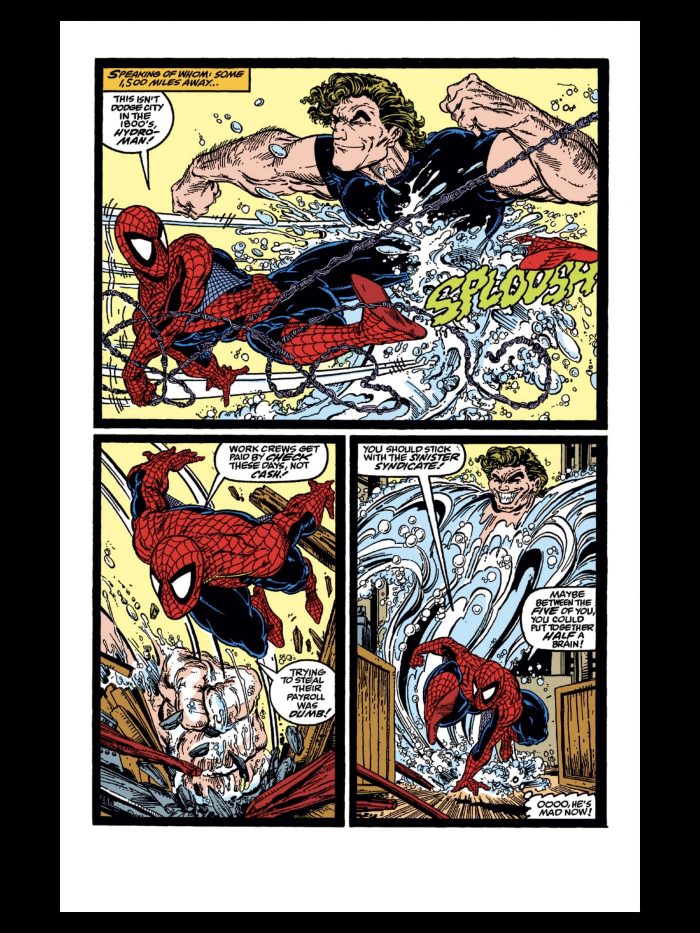
Hydro-Man even filled the Sandman role in the Sinister Syndicate, an off-brand version of the Sinister Six. His most memorable solo appearance in the early Modern Age of comics was perhaps Amazing Spider-Man #315, where he came to life via Todd McFarlane art.
Even in an issue where he graced the cover, however, Hydro-Man was reduced to a three-page encounter with Spider-Man before he retreated down a storm drain. In Far from Home, Hydro-Man shows up in the canals of Venice, the perfect place for a water-based villain to wreak havoc.
Peter dons a Venetian mask to fight him alongside Mysterio while bystanders remark on how they are "kicking that water's ass." After they have defeated him, Flash Thompson sees a Buzzfeed article on his smartphone making the dubious claim that an experimental underwater generator imbued a man named Morris Bench with hydro powers. It's a cute acknowledgement of Hydro-Man's comics origin, but as it turns out, it's not true, because the Water Elemental is merely a hologram.
The Fire Elemental, which attacks the Ferris wheel in Prague, certainly looks molten, if not quite like Molten Man from the comics. He's got his own Funko Pop! figure already, as does Hydro-Man, but really, it's only the barest visual nod that links this Elemental to his comics counterpart.
According to the MCU Wiki, the final Elemental is based on Whirlwind, but honestly, if you hadn't told me that, I wouldn't have guessed it, either. In the comics, Whirlwind was more of an Avengers villain. In the movie, he (technically, it) is depicted as a raging cloud, made up of all the other Elementals combined.
Mysterio, Master of Illusions
Mysterio has one of the more comics-accurate villain costumes that we've seen in the MCU thus far. Having a special-effects artist — like Quentin Beck was in the comics — be the villain might be a bridge too far in terms of movie-artifice reminders, so the Mysterio that we see in Far from Home gets a high-tech makeover that sees him casting illusions with a holographic system. There's still a wink at Hollywood moviemaking magic when we see him strutting around in a mo-cap suit toward the end.
The way the film withholds Mysterio's true nature, playing it as a rug to be pulled later on, is in accordance with the late reveal in several comic stories. In Amazing Spider-Man #311, another issue with Todd McFarlane art, Mysterio tricked Spider-Man into thinking that he had failed to save a mugging victim from being killed. It was only when Spider-Man returned to the scene later to retrieve his camera (the one he used in his civilian identity as a Daily Bugle photographer) that he realized the whole incident had been a trick.
Mysterio has also messed with the head of other Marvel heroes, not just Spider-Man. In the "Guardian Devil" storyline, written by filmmaker Kevin Smith and pencilled by future Marvel Comics Editor-in-Chief Joe Quesada, Mysterio tried to drive Daredevil insane by means of an elaborate scheme involving an immaculately conceived child who was either the Second Coming or the Antichrist.
In "Old Man Logan," which partially inspired the last Wolverine film, Logan, Mysterio also succeeded in fooling Wolverine into killing the X-Men by making him think they were supervillains attacking the X-Mansion. This took place in an alternate future, not the Earth-616 timeline. (There's another Easter egg in Far from Home where Mysterio refers to the MCU as Earth-616.)
The page where Mysterio revealed himself to Wolverine was a gut punch. With the X-Men dead and Jubilee's fresh corpse lying bloody in arms, Wolverine could only look on in absolute shock as the villain said, "My name is Mysterio, the master of illusions. My thanks on behalf of the criminal community."
The Peter Tingle and Into the Costume-Verse
The first costume that we see Spider-Man wearing in Far from Home is that of the Iron Spider, which made its comics debut during the Civil War event and its screen debut last year during Avengers: Infinity War. Aunt May (Marisa Tomei) packs Peter's regular, foldable costume in his suitcase for him, which leads to an awkward moment when he's passing through airport security. She's also the one who first introduces us to the concept of the "Peter Tingle," the MCU's makeshift, comedic name for Spider-Man's Spider-Sense.
The comics depicted the Spider-Sense as a series of zigzagging lines above Spider-Man's head. It alerted him to danger, as it does in the movie, though bananas being tossed his way don't qualify as danger. This isn't the first intimation of the Spider-Sense that we've seen in the MCU. When Peter was on the school bus in Infinity War, we saw the hairs on his arm raise up, alerting him to the arrival of the Black Order's ship in New York.
As mentioned, Peter dons a Venetian mask when he's in Venice, and Nick Fury later outfits him with a goggled stealth suit inspired in part by the one in the Spider-Man: Noir comic. It's a tactical costume reminiscent of those that S.H.I.E.L.D. operatives like Black Widow once wore, so there's no trench coat as there was with Nicolas Cage's cartoon version of the Spider-Man: Noir character (seen last year in Into the Spider-Verse).
After Happy Hogan picks Peter up in a private jet from a tulip field in the Netherlands, Peter uses the jet's onboard system to custom-design yet another new Spider-Man costume for himself. The days of him swinging around in a "onesie" like he was before he met Tony are clearly over. At the rate he's going with all these costume changes, Spider-Man might as well enter a colorful Costume-Verse for his next sequel by means of a walk-in closet. "Spider-Man: Into the Wardrobe?"
MJ and the Not-So-Secret Identity
"Who let Vicky Vale into the Batcave?" This is a line from Batman Returns that rather knowingly addresses how little Tim Burton's Batman — or at least its version of Alfred the butler — seemed to respect the sanctity of the secret identity. Masks were more of a thing in comics, with the need to protect one's loved ones from vengeful enemies being of paramount importance. If you pull a superhero film title out of a hat, however, you could probably start counting off, right away, some characters in that film who know the superhero's secret identity.
Civil War immediately let Tony Stark and Happy Hogan in on Spider-Man's secret. Homecoming added Ned Leeds, Adrian Toomes, and Aunt May to the circle of people who knew. Before its closing credits roll, Far from Home also adds Nick Fury and Maria Hill, Quentin Beck, and MJ.
Zendaya's version of MJ — which, in the MCU, is short for Michelle Jones — has already been a departure from Mary Jane Watson, the MJ of Marvel Comics and Raimi's Spider-Man trilogy (played by Kirsten Dunst). Instead of being a red-haired, voluptuous fashion model like she was in the comics, this MJ is an academic decathlete with no friends and a dry, mocking sense of humor. She's more interested in the Black Dahlia murder than fashion.
Using her observational skills, MJ is able to deduce that Peter is Spider-Man fairly easily, blurting it out on the bridge in Prague right as he's about to confess his feelings for her by way of a dahlia necklace that he picked up for her in Venice. There's a precedent for MJ figuring out Peter's identity as Spider-Man in the comics. In Amazing Spider-Man #258, she informed Peter that she had known his secret for years.
On the comics page, she was more upset about him lying to her all this time than she is in the movie. At the time, Peter's heart actually belonged to another: he and Felicia Hardy, the Black Cat, were an item.
On a side note, issue #258 was an eventful one for other reasons, too. It's the issue where Peter goes to have his new black costume, which he acquired on another planet during the Secret Wars miniseries, tested by Reed Richards of the Fantastic Four. Richards' tests show that the costume is, in fact, a living alien symbiote. He uses a sonic blaster to separate it from Peter's body, and as we all know, the symbiote would later go on to bond with Eddie Brock and become Venom (who, in turn, would go on to to be played by Tom Hardy in last year's Venom feature film).
The mid-credits scene of Spider-Man: Homecoming showed Toomes (Michael Keaton) in prison, where he chose not to reveal Peter's secret identity to his former criminal associate, Mac Gargan. Far from Home's own mid-credits scene delivers up a slant rhyme to that moment, as Mysterio announces to the world in a video recorded before his apparent demise that Peter Parker is Spider-Man. We also see J.K. Simmons make his surprise debut as J. Jonah Jameson: bridging the gap between the MCU and Raimi's Spider-Man trilogy and marking the first time an actor has played the same character both outside the franchise and within its continuity.
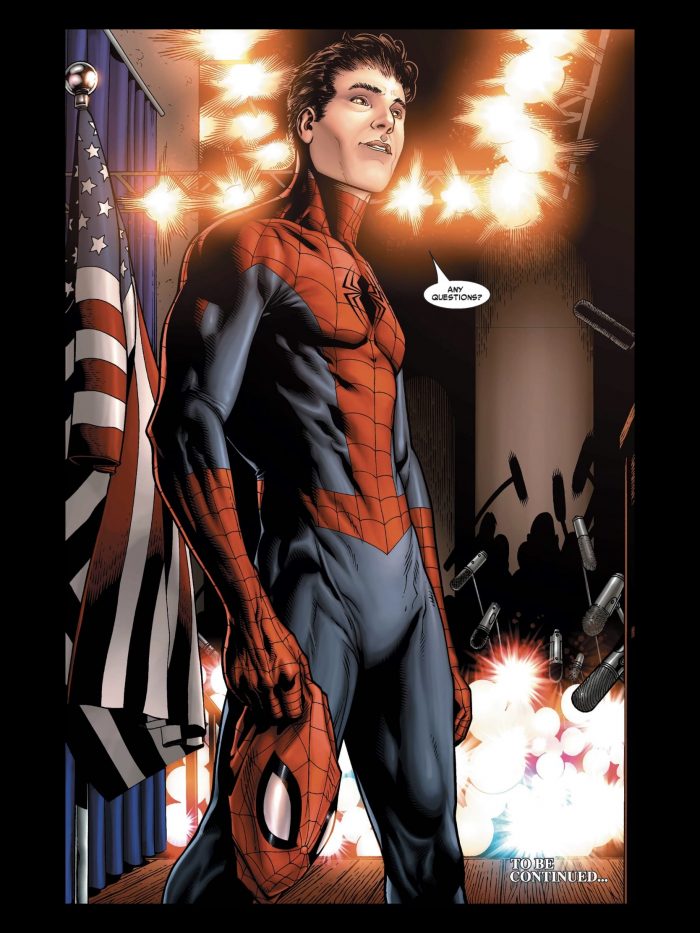
As I wrote last year when talking about the Marvel Comics moments that Infinity War brings to life, the mentoring dynamic that we've seen onscreen between Tony Stark and Peter Parker has its roots in the Civil War and pre-Civil-War era of comics. At the end of Civil War #2, Tony brought Spider-Man out at a press conference, where the hero made a conscious decision to unmask himself as Peter.
At the conclusion of the very first MCU film, Tony did a similar thing, sans Spider-Man, when he made the public announcement that he was Iron Man. It's a scene that effectively dismantled the dual identity trope and presented Tony as a new kind of rock-star superhero who could enjoy the trappings of Iron Man fame even when he was in his civilian guise. Having Peter outed as Spider-Man, even against his will, brings him full circle to where he is now in the same place as Tony at the end of that first movie.
It puts the web-slinger in an interesting position going into Phase Four. We know there are bad guys like Mac Gargan who are already out to get him. What's more, Gargan has his own supervillain alter ego in the comics: that of the Scorpion, a character we haven't seen in the movies yet. Vulture is also still sitting in jail, and with Mysterio being a master of illusions who spoke of having contingency plans, it's possible that he faked his death (though I'd rather take it at face value for now, until we hear some concrete news that gives us reason to believe otherwise).
There's also the little matter of Mysterio having framed Spider-Man for the drone attacks in Far from Home. With Peter's name out there now and J. Jonah Jameson looking to make Spider-Man public enemy number one, he and his friends and family are suddenly much more vulnerable.
At the same time, plenty of heroes in the MCU have been able to live for years with their identities known to the world. Tony's declaration, "I am Iron Man," somewhat weakened the currency of secret identities going forward from the first MCU film. The Mandarin did launch a helicopter attack on Tony's Malibu home in Iron Man 3, but that was the result of direct goading from Tony.
Keep in mind, Peter's not just some friendly neighborhood Spider-Man anymore. He may have once been a kid with no connections but now he's got Happy Hogan and Stark Industries tech backing him.
Skrulls and the Cosmic Future of Phase Four
Nick Fury also wants to be in Spider-Man's corner. We can infer that even before the redirect to Prague, Fury was pulling the strings of the travel agency behind Peter's school trip. Seriously, would a New York public school have been able to afford a trip like that any other way?
Maybe where the story has been leading with Spider-Man in the MCU is that he will graduate high school and become a full-time Avenger. There was a nice little moment in Endgame where he and Captain Marvel introduced themselves to each other ("Hey, Peter Parker, you got something for me?"), so if she assumes the leadership duties over a new Avengers team like she has in the comics, they'll already be acquainted.
Nick Fury isn't the only Captain Marvel character we see in Far from Home. There's also Talos and his wife Soren, the two Skrulls who — in the film's post-credits scene — are revealed to have been impersonating Nick Fury and Maria Hill all along. The real Nick Fury is up in space, where he's vacationing on a ship full of Skrulls.
As superficially grounded as Far from Home is, the very last image it leaves the viewer with is one that seems to hint at a more cosmic future for the MCU. Last year, I theorized that we might see Phase Four taking an Avengers-in-space approach. I joked that we might see a post-credits scene with Nick Fury telling the Phase Three survivors: "You think you're the only heroes in the universe? You're about to become part of a bigger cosmos."
Far from Home doesn't dress it up in the same exact dialogue as Iron Man's post-credits scene, but the implication is still pretty clear that cosmic things are on the horizon. Can the Skrulls be trusted? Captain Marvel framed them as refugees who were persecuted by the Kree, but in the comics, the Skrulls were behind a full-scale secret invasion of Earth.
Even if Talos remains a good guy, there are enough Skrulls on that ship with Fury that it's conceivable a rogue element could form among them. The Skrulls in the MCU are in a similar position to the ones in the Secret Invasion comics storyline in that they have lost their home world. If a rogue element did form, it's possible they might see Earth as the rightful replacement for their world and seek to depose or subjugate the humans who live there.
This could involve seeding the planet with imposters, replacing heroes with their own sleeper agents like in the comics. We still don't know the film slate for Phase Four, of course, though we may finally hear an official announcement later this month at San Diego Comic-Con. Whatever the future holds in store for Peter Parker, he's been to space once already, as Talos-Nick so astutely points out in Far from Home. With films like Guardians of the Galaxy Vol. 3, Captain Marvel 2, and The Eternals in the pipeline, don't expect to see a lot of Earth-based Elementals in Marvel's future.

